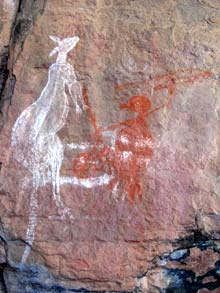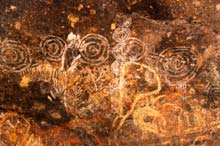|

April 5, 2008
If, like me, you’re a devotee of the deity Chocolatl, you will have an inkling of why the sweet-swollen honey ant, the subject of John Conway’s April article “Sweet Dreams,” could have become an important clan ancestor in the mythic “Dreamtime” of Australia’s aboriginal inhabitants,
and a subject of sacred art. (Evolution made concentrated sugar sources precious to us.)
Apparently there’s a lot of new-age bull on the Web about the Dreamtime, the spiritual power source of Aboriginal culture. It would be easy to be taken in. How do I know it’s bull? Look at the reader reviews here and you’ll get the picture. Unfortunately there’s an air of “those who speak don’t know, those who know don’t speak” around the subject. Here (PDF) is one of the best outsider’s accounts, by Australian anthropologist (and great character) W.E.H. “Bill” Stanner (1956), still used as a text in anthropology courses:
Although, as I have said, The Dreaming conjures up the notion of a sacred, heroic time of the indefinitely remote past, such a time is also, in a sense, still part of the present. One cannot "fix" The Dreaming in time: it was, and is, everywhen. We should be very wrong to try to read into it the idea of a Golden Age, or a Garden of Eden, though it was an Age of Heroes, when the ancestors did marvelous things that men can no longer do. The aborigines . . . do not, in aversion from present or future, look back on it with yearning and nostalgia. Yet it has for them an unchangeably sacred authority.
Clearly, The Dreaming is many things in one. Among them, a kind of narrative of things that once happened; a kind of charter of things that still happen; and a kind of logos or principle of order transcending everything significant for aboriginal man. If I am correct in saying so, it is much more complex philosophically than we have so far realized. I greatly hope that artists and men of letters who (it seems increasingly) find inspiration in aboriginal Australia will use all their gifts of empathy, but avoid banal projection and subjectivism, if they seek to borrow the notion.
We’ve all seen the striking acrylic paintings that have shared traditional images of the Australian Dreamtime (including Honey Ant Ancestor), once confined to sacred sand paintings, with the world, but I had never heard the story of how they came to be—through the efforts of another devoted go-between:
In 1971, a hopeful, young art teacher drove the long, lonely road from Alice Springs to the Aboriginal outpost settlement at Papunya. His name was Geoffrey Bardon. Eighteen months later, he left Papunya, defeated by a hostile white authority. But his legacy was the beginnings of the Western Desert Painting Movement.
What started as an exercise to encourage the Aboriginal schoolchildren to record their sand patterns and games grew to involve, at the peak of creativity, as many as 30 tribal men and elders. With Bardon’s encouragement, these men worked to preserve their traditional Dreamings and stories in paint. . . .
Even when it came to Aboriginal art, however, Bardon was going where one white man—the magisterial Bill Stanner—had gone before.


(Annie Gottlieb) |
Comments (add yours!)

Return to April home
|



